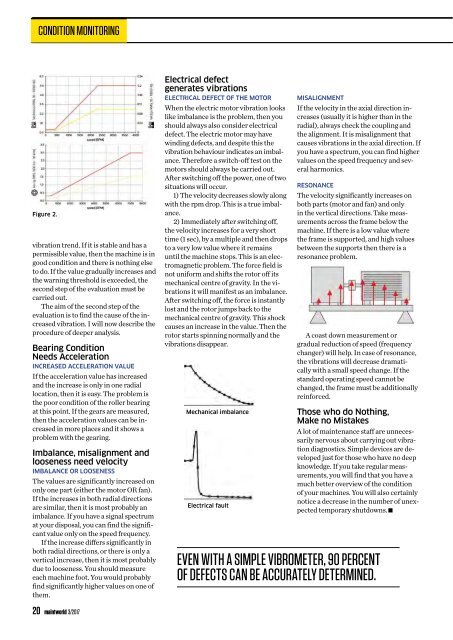Maintworld 3/2017
In this issue: Using Technology and Innovation to Manage Mega-Maintenance Challenges Identify the Root Cause of a Misalignment Condition Elements of a Good Preventive Maintenance Program
In this issue:
Using Technology and Innovation to Manage Mega-Maintenance Challenges
Identify the Root Cause of a Misalignment Condition
Elements of a Good Preventive Maintenance Program
Create successful ePaper yourself
Turn your PDF publications into a flip-book with our unique Google optimized e-Paper software.
CONDITION MONITORING<br />
Figure 2.<br />
vibration trend. If it is stable and has a<br />
permissible value, then the machine is in<br />
good condition and there is nothing else<br />
to do. If the value gradually increases and<br />
the warning threshold is exceeded, the<br />
second step of the evaluation must be<br />
carried out.<br />
The aim of the second step of the<br />
evaluation is to find the cause of the increased<br />
vibration. I will now describe the<br />
procedure of deeper analysis.<br />
Bearing Condition<br />
Needs Acceleration<br />
INCREASED ACCELERATION VALUE<br />
If the acceleration value has increased<br />
and the increase is only in one radial<br />
location, then it is easy. The problem is<br />
the poor condition of the roller bearing<br />
at this point. If the gears are measured,<br />
then the acceleration values can be increased<br />
in more places and it shows a<br />
problem with the gearing.<br />
Imbalance, misalignment and<br />
looseness need velocity<br />
IMBALANCE OR LOOSENESS<br />
The values are significantly increased on<br />
only one part (either the motor OR fan).<br />
If the increases in both radial directions<br />
are similar, then it is most probably an<br />
imbalance. If you have a signal spectrum<br />
at your disposal, you can find the significant<br />
value only on the speed frequency.<br />
If the increase differs significantly in<br />
both radial directions, or there is only a<br />
vertical increase, then it is most probably<br />
due to looseness. You should measure<br />
each machine foot. You would probably<br />
find significantly higher values on one of<br />
them.<br />
Electrical defect<br />
generates vibrations<br />
ELECTRICAL DEFECT OF THE MOTOR<br />
When the electric motor vibration looks<br />
like imbalance is the problem, then you<br />
should always also consider electrical<br />
defect. The electric motor may have<br />
winding defects, and despite this the<br />
vibration behaviour indicates an imbalance.<br />
Therefore a switch-off test on the<br />
motors should always be carried out.<br />
After switching off the power, one of two<br />
situations will occur.<br />
1) The velocity decreases slowly along<br />
with the rpm drop. This is a true imbalance.<br />
2) Immediately after switching off,<br />
the velocity increases for a very short<br />
time (1 sec), by a multiple and then drops<br />
to a very low value where it remains<br />
until the machine stops. This is an electromagnetic<br />
problem. The force field is<br />
not uniform and shifts the rotor off its<br />
mechanical centre of gravity. In the vibrations<br />
it will manifest as an imbalance.<br />
After switching off, the force is instantly<br />
lost and the rotor jumps back to the<br />
mechanical centre of gravity. This shock<br />
causes an increase in the value. Then the<br />
rotor starts spinning normally and the<br />
vibrations disappear.<br />
Mechanical imbalance<br />
Electrical fault<br />
MISALIGNMENT<br />
If the velocity in the axial direction increases<br />
(usually it is higher than in the<br />
radial), always check the coupling and<br />
the alignment. It is misalignment that<br />
causes vibrations in the axial direction. If<br />
you have a spectrum, you can find higher<br />
values on the speed frequency and several<br />
harmonics.<br />
RESONANCE<br />
The velocity significantly increases on<br />
both parts (motor and fan) and only<br />
in the vertical directions. Take measurements<br />
across the frame below the<br />
machine. If there is a low value where<br />
the frame is supported, and high values<br />
between the supports then there is a<br />
resonance problem.<br />
A coast down measurement or<br />
gradual reduction of speed (frequency<br />
changer) will help. In case of resonance,<br />
the vibrations will decrease dramatically<br />
with a small speed change. If the<br />
standard operating speed cannot be<br />
changed, the frame must be additionally<br />
reinforced.<br />
Those who do Nothing,<br />
Make no Mistakes<br />
A lot of maintenance staff are unnecessarily<br />
nervous about carrying out vibration<br />
diagnostics. Simple devices are developed<br />
just for those who have no deep<br />
knowledge. If you take regular measurements,<br />
you will find that you have a<br />
much better overview of the condition<br />
of your machines. You will also certainly<br />
notice a decrease in the number of unexpected<br />
temporary shutdowns.<br />
EVEN WITH A SIMPLE VIBROMETER, 90 PERCENT<br />
OF DEFECTS CAN BE ACCURATELY DETERMINED.<br />
20 maintworld 3/<strong>2017</strong>

















